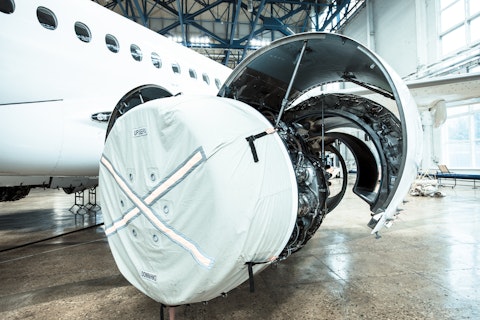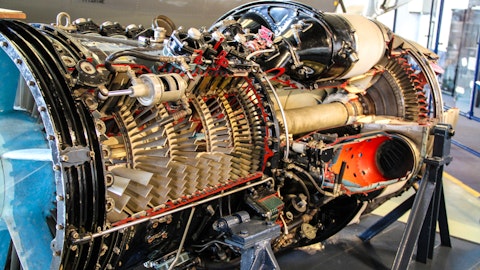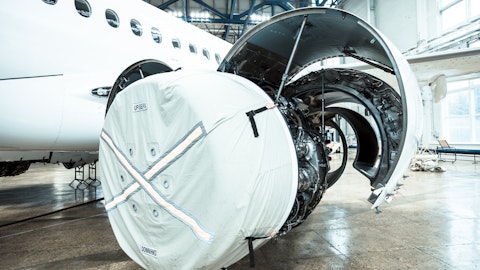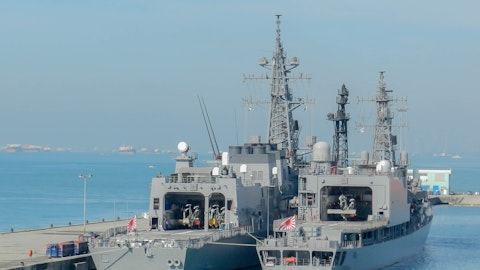Woodward, Inc. (NASDAQ:WWD) Q4 2022 Earnings Call Transcript November 17, 2022
Woodward, Inc. beats earnings expectations. Reported EPS is $0.84, expectations were $0.76.
Operator: Thank you for standing by. Welcome to the Woodward, Inc. Fourth Quarter Fiscal Year 2022 Earnings Call. At this time, I’d like to inform you that this call is being recorded for rebroadcast and then all participants are in a listen-only mode. Following the presentation, you are invited to participate in a question-and-answer session. Joining us today from the company are Mr. Chip Blankenship, Chairman and Chief Executive Officer; Mr. Mark Hartman, Chief Financial Officer; and Mr. Dan Provaznik, Director of Investor Relations. I’d now like to turn the call over to Mr. Provaznik.
Dan Provaznik: Thank you, operator. We would like to welcome all of you to Woodward’s fourth quarter fiscal year 2022 earnings call. In today’s call, Chip will comment on our strategies and related markets. Mark will then discuss our financial results as outlined in our earnings release. At the end of the presentation, we will take questions. For those who have not seen today’s earnings release, you can find it on our website at woodward.com. We have included some presentation materials to go along with today’s call that are also accessible on our website. An audio replay of this call will be available by phone through December 1, 2022 or on our website. The phone number for the audio replay is on the press release announcing this call as well as on our website and will be repeated by the operator at the end of the call.

Alexey Y. Petrov/Shutterstock.com
I would like to refer to and highlight our cautionary statement as shown on Slide 3. As always, elements of this presentation are forward-looking or based on our current outlook and assumptions for the global economy and our businesses more specifically, including the expected and potential events, effects of the ongoing supply chain and labor disruptions and net inflationary pressures. Those elements can and do frequently change. Our forward-looking statements are subject to a number of risks and uncertainties surrounding those elements, including the risks we identify in our filings. In addition, Woodward is providing certain non-U.S. GAAP financial measures. We direct your attention to the reconciliations of non-U.S. GAAP financial measures, which are included in today’s slide presentation and our earnings release and related schedules.
We believe this additional financial information will help in understanding our results. Also, all comparisons made during this call are to the same period of the prior year, unless otherwise stated. Now I’ll turn the call over to Chip.
Chip Blankenship: Thank you, Dan, and good afternoon, everyone. During fiscal 2022, our market strengthened and demand was solid with the exception of China. Challenges from supply chain and labor disruptions, record high inflation and unfavorable foreign currency exchange rates negatively impacted our performance. We expect some improvements in fiscal 2023 and we are taking specific actions to manage key constraints that are within our control. We remain focused on operational excellence, talent development and innovation to help drive the company’s performance and create value for our shareholders. Orders are up in nearly all market segments, and we finished the year with a strong backlog. Moreover, our past due commitments to customers remain elevated as a result of part shortages and labor inefficiencies.
On our last call, we discussed our strategy to mitigate supply chain risk and better position Woodward for long-term success. I’d like to update you on three actions we’ve taken. We have redeployed talent and added indirect resources to factories to stabilize the production environment. This support includes material planning resources, operations specialists, leadership support and engineers. Secondly, we reinforced the global sourcing team to secure additional supplier capacity and allocated experienced resources to help suppliers resolve issues. We have also found and qualified a number of new quick-turn suppliers that we’re using to augment specific supplier shortages. Third, our advanced manufacturing engineers across the company are working to transfer selected machine components into our own plants.
This in-sourcing activity leverages our substantial machining capabilities and capacity, which we expect will deliver improvements in quality, delivery and cost and reduce our lead times. To date, more than 2,000 parts have been transitioned to alternative sources, either in-house or to a more capable third-party supplier. While significant work remains, we believe these investments will help stabilize our supply chain and improve output. To support the in-sourcing initiatives, we’re more effectively utilizing existing equipment to relieve capacity constraints at suppliers. While we have the capital largely in place, we’re investing $10 million of new capital to create rapid response machining centers at four of our sites. These machining centers include flexible CNC machines that will have a portion of their capacity available for rapid response when a supplier has unforeseen problems.
That capital will begin arriving in our plants in the second quarter, and our target is to produce parts in less than 10 days from the time we identify a supplier shortage. I’d like to take this opportunity to thank our members for their efforts and commitment to Woodward and our customers. They have stepped up in the face of adversity to help us serve customers better and deliver for our shareholders. From members meeting elevated build rate targets, to engineers we deploy to assist problem-solving its suppliers and advanced manufacturing engineers bringing automation and in-sourcing initiatives online, just to name a few examples. Like others in the industry, we continue to grapple with the increasingly competitive labor market, challenging attrition rates and skills gaps.
Hiring, developing and retaining talent are critical components to our long-term sustainable success and remain a top priority. We have initiatives underway to improve training and development. Our new machinists and technicians undergo a rigorous, multi-month training and skills development process that enables them to perform to Woodward’s high standards. We’re focused on compressing the training cycle time to develop our members quickly and efficiently without compromising safety or quality. We’re partnering with select technical schools to help augment our training bandwidth. We’re also increasing our focus on automation with multiple technology paths, including expanded use of cobots or collaborative robots. We’re encouraged by the results and believe the increased use of automation will deliver productivity and mitigate risk in a difficult labor market.
Turning to innovation. Woodward is committed to solving our customers’ fuel and motion control challenges, enabling improved fuel efficiency and reduced emissions in both aerospace and industrial applications. While we are investing in and developing innovative technologies that reduce fuel consumption and associated emissions, we’re seeing rising interest in the use of alternative fuels across both industrial and aerospace industries. Together with our customers, we are developing solutions that enable a wide variety of clean fuels to power the engines of tomorrow. Our focus on innovation enables multiple paths to a cleaner decarbonized world, which we believe represents a significant opportunity for our company in the future. Woodward has been selected as a partner to provide substantial content on a very large breakthrough aerospace project involving carbon emissions reduction that will be announced in the next few weeks.
This is a significant project for Woodward involving resources and test facilities across both our Aerospace and Industrial businesses. Additionally, our Industrial segment is working on projects with 8 different customers on a variety of clean fuels, including ethanol, hydrogen, methanol, ammonia and bio-derived natural gas. These projects are for a wide variety of applications, including power generation, marine, agriculture and mining, targeting both new engines as well as conversion and upgrade opportunities for engines currently in service. Now moving to our markets, demand from both aerospace and industrial customers remain strong. In aerospace, utilization rates for commercial airline fleet continued to rise, driven by increasing global passenger traffic.
U.S. and European domestic passenger traffic has returned to near 2019 levels. International travel continues to improve, yet China domestic passenger traffic remains volatile. In the defense market, we anticipate near-term U.S. procurement to increase slightly and geopolitical tensions may lead to increased international defense spending. In industrial markets, we are seeing robust demand in power generation, driven by strong growth in Asia, continued increases in global aftermarket activity and ongoing demand for backup power at data centers. In transportation, the global marine market remains healthy with higher ship utilization which drives increases in current and future aftermarket activity. Cruise and ferry operations are back at near 2019 levels, which should result in increased spare parts demand.
In addition, the global marine market interest for alternative fuels is increasing as more projects are announced and under development. Demand for China natural gas trucks remains at depressed levels. The oil and gas market is favorable as equipment utilization remains elevated. These factors should result in increased aftermarket demand. In summary, we believe our markets will remain strong as heightened demand signals for fiscal year 2023 continue to propagate throughout our markets as customers continue to increase orders. We remain focused on improving operations to catch up on past due orders and deliver on future customer demand. We are committed to operational excellence initiatives, talent development and innovation, which we believe will deliver value to our customers and shareholders and will position Woodward to capitalize on future market opportunities.
I will now turn the call over to Mark to review our quarterly and full year results and our fiscal year 2023 outlook.
See also 16 Biggest Utility Companies in the US and 12 Most Advanced Countries in Electronics.
Mark Hartman: Thank you, Chip. Net sales for the fourth quarter of fiscal 2022 were $640 million, an increase of 12%. In the quarter, we realized $29 million in price gains or an increase of approximately 5%. Sales for the quarter were negatively impacted by approximately $85 million due to ongoing global supply chain and labor disruptions. Sales were also impacted by approximately $24 million from unfavorable foreign currency exchange rates. Turning to our segments, starting with Aerospace, segment sales for the fourth quarter of fiscal 2022 were $408 million, an increase of 8%. Commercial aftermarket and OEM sales were up 34% and 24%, respectively, driven by continued recovery in both domestic and international passenger traffic and increasing aircraft utilization as well as higher OEM build rates.
The increase in segment sales was partially offset by delayed shipments of approximately $40 million caused by global supply chain and labor disruptions. Defense OEM sales were down 18%, primarily due to lower guided weapons demand. Defense aftermarket sales were down 7% due to global supply chain and labor disruptions. Aerospace segment earnings for the fourth quarter of 2022 were $63 million or 15.5% of segment sales compared to $66 million or 17.4% of segment sales. The decrease in segment earnings was a result of net inflationary impacts on material and labor costs as well as increases in manufacturing costs related to supply chain disruptions and inefficiencies related to training recent hires, partially offset by higher sales volume. For fiscal year 2022, Aerospace segment sales were $1.52 billion compared to $1.40 billion for the prior year, an increase of 8%.
The Aerospace segment earnings for fiscal year 2022 were $231 million or 15.2% of segment sales compared to $234 million or 16.7% of segment sales for the prior year. Turning to Industrial, Industrial segment sales for the fourth quarter of fiscal 2022 were $232 million compared to $193 million, an increase of 20%. The increase was driven by higher marine sales from continued utilization of the in-service fleet and strong industrial turbomachinery sales due to the growing demand for power generation and process industries. This increase was partially offset by delayed shipments of approximately $45 million due to global supply chain and labor disruptions and unfavorable currency exchange rate impacts of approximately $22 million. Industrial segment earnings for the fourth quarter of 2022 were $21 million or 9.0% of segment sales compared to $21 million or 10.7% of segment sales.
The favorable impact from higher sales was offset by increases in manufacturing costs related to supply chain and labor disruptions, costs associated with training recent hires, net inflationary impacts on material and labor costs as well as unfavorable foreign currency impacts. Fiscal 2022 Industrial sales were $863 million compared to $842 million for the prior year, an increase of 3%. Industrial segment earnings for fiscal 2022 were $83 million or 9.6% of segment sales. Industrial segment earnings for 2021 were $109 million or 12.9% of segment sales. Non-segment expenses remained consistent at $17 million for the fourth quarter of 2022 and 2021. Adjusted non-segment expenses for the fourth quarter of 2022 were $21 million compared to $12 million in fiscal 2021.
Non-segment expenses were $81 million for fiscal 2022 compared to $64 million for 2021. Adjusted non-segment expenses were $78 million in fiscal 2022 compared to $59 million. At the Woodward level, R&D costs for the fourth quarter of 2021 were $30 million or 4.7% of sales compared to $28 million or 4.9% of sales. For fiscal year 2022, R&D costs were $120 million or 5.0% of sales compared to $117 million or 5.2% of sales. SG&A expenses for the fourth quarter of 2022 were $50 million compared to $38 million. For fiscal year 2022, SG&A expenses were $203 million compared to $187 million. The effective tax rate was 6.5% for the fourth quarter of 2022 compared to 18.2%. The adjusted effective tax rate was 5.3% for the fourth quarter of 2022 compared to 18.8%.
The full year effective tax rate was 14.1% for fiscal 2022 compared to 15.1%. The adjusted effective tax rate was 14.3% for fiscal 2022 compared to 15.3%. Looking at cash flows. Net cash provided by operating activities for fiscal 2022 was $194 million compared to $465 million. Capital expenditures were $53 million for 2022 compared to $38 million. Free cash flow was $141 million for fiscal 2022 compared to free cash flow of $427 million. The decrease in free cash flow for 2022 was primarily related to working capital increases as a result of production delays from supply chain disruptions as well as lower earnings. Leverage was 2.1x EBITDA at the end of the fourth quarter. We also have significant liquidity consisting of $1.1 billion of combined cash on hand and revolver capacity.
During fiscal 2022, $518 million was returned to stockholders in the form of $473 million of repurchased shares and $45 million in dividends. Lastly, turning to our 2023 outlook. Our fiscal 2023 outlook assumes improving operational and financial performance throughout the year while navigating a challenging industry-wide environment. The supply chain and labor disruptions are anticipated to begin to subside during fiscal 2023, with the expected pace of improvement increasing in the second half of the year. However, the pace of improvement is uncertain and the results could be negatively impacted if supply chain and labor disruptions do not improve as anticipated. The strong demand environment is expected to continue with price realization ramping over the course of the year.
We expect the full year price realization to be in the range of 5%, consistent with the fourth quarter of fiscal 2022. We anticipate total net sales for fiscal 2023 to be between $2.60 billion and $2.75 billion. Aerospace sales growth is expected to be between 14% and 19%. Industrial sales growth is expected to be flat to up 5%. Our Aerospace outlook assumes increases in OEM build rates and overall global passenger traffic as well as higher aircraft utilization rates. Military sales are expected to increase slightly as global military budgets begin to rise. Industrial sales are expected to be supported by demand for power generation equipment, rising oil and gas investments and a stable global marine market, partially offset by continuing unfavorable foreign currency exchange rates.
China natural gas truck sales are expected to remain at depressed levels. Aerospace segment earnings as a percent of segment net sales are expected to increase by approximately 150 to 200 basis points driven by increased sales volume and price realization in both commercial OEM and aftermarket, partially offset by the return of annual variable incentive compensation costs. Industrial segment earnings as a percent of segment net sales are expected to be flat year-over-year due to increased sales volume and price realization offset by the return of annual variable incentive compensation costs. EBIT is expected to include approximately $60 million of annual variable incentive compensation costs, an increase of approximately $50 million over the prior year.
We anticipate our interest expense will increase by approximately $10 million primarily due to rising interest rates. The effective tax rate is expected to be approximately 19%. Free cash flow is expected to be between $200 million to $250 million. Capital expenditures are expected to be approximately $80 million. Earnings per share is expected to be between $3.15 and $3.60 based on approximately 61 million of fully diluted weighted average shares outstanding. The favorable earnings impact of anticipated sales growth and price realization improvements, in addition to our ongoing efforts to improve operational performance are expected to be partially offset by the anticipated return of full annual variable compensation costs. Finally, to assist in your modeling, a few reminders.
First, our fiscal first quarter contains fewer working days than the preceding and subsequent quarters due to the holidays. Therefore, we anticipate fiscal Q1 results will be lower sequentially and lower than the other three quarters in fiscal 2023. Second, many of our OEM contracts have price escalation clauses that go into effect on January 1. And third, we anticipate the pace of improvement across the supply chain will increase in the second half of the year. This concludes our comments on the business and the results for the fourth quarter of 2022. Before we move into questions, I would like to announce that we will be holding our Investor and Analyst Day in early June 2023 and we will hopefully see many of you there. Operator, we are now ready to open the call to questions.
Q&A Session
Follow Woodward Inc. (NASDAQ:WWD)
Follow Woodward Inc. (NASDAQ:WWD)
Operator: Thank you. Our first question is from Sheila Kahyaoglu with Jefferies. Your line is open.
Sheila Kahyaoglu: Hi, good afternoon, guys and thank you for the time. Maybe if you could talk about your guidance for Aerospace of 14% to 19% growth and how you think about the different pieces and your expectations within that? And what how you’re thinking about price? Is that consistent with in Aerospace 5 points in 2022 and into 2023?
Mark Hartman: Yes. Thanks, Sheila. I’ll answer your last question first. The price increase I mentioned in the range of 5% is both across Aerospace and Industrial, generally consistent across both of those. Related to the Aerospace growth of 14% to 19%, we do anticipate continued growth on the commercial both the OEM and the aftermarket side. On the commercial OEM side, with some increasing build rates from the aircraft manufacturers. On the aftermarket side, we’re anticipating the aftermarket continues to have strength related to the utilization of the aircraft and the passenger mileage or passenger miles increase that we continue to see. So as we look across the as we’ve talked in the past, we look across the aircraft that are flying that is favorable to Woodward based on the content on the dynamics of the aircraft that are flying and so that has a positive effect for us also.
Sheila Kahyaoglu: How can we and just maybe specifically on the commercial aftermarket, how do we think about that into 2023? And maybe can you talk about the aftermarket in the context of like supply chain issues, LEAP reliability and just delayed deliveries, how that kind of combines into your aftermarket forecast?
Chip Blankenship: So Sheila, this is Chip. Good afternoon. How you’re doing?
Sheila Kahyaoglu: Good, thank you.
Chip Blankenship: Good talk to you. So we see strong inputs to our overhaul facilities right now from the commercial aircraft and the content that we have on them, both narrow-body and wide-body. So we feel strong about that continued strong inputs and our ability to deliver. So we have some supply chain challenges from part shortages, and that’s created some past dues to customers. We’re bringing more of the machine parts inside our own facilities. So we’re able to support our overhaul with spare parts a little bit better as we forecast that into the future. We’ve had some of the same impacts in our defense aftermarket production and return to customers as well. And we’re going after that problem solving in the same way by insourcing and alleviating some of the supply chain challenges by moving the parts.
Sheila Kahyaoglu: Okay. Great. Thanks so much, Chip. Thank you, Mark.
Chip Blankenship: Yes. Thank you.
Operator: The next question is from Chris Glynn with Oppenheimer. Your line is open.
Chris Glynn: Thanks. Good afternoon, and appreciate the extensive detail on the guidance up and down the P&L. So the guidance came with some caveats, talk about relative to your expected pace of steady improvements in some of the supply chain and labor things going on. But what might be your ability on those efforts to kind of break through and beyond the guidance assumptions? It doesn’t seem like you’re claiming any victory, but you have real deliberate efforts going on. So just curious about the sense that some of those things could really kind of break through and normalize your operations a little more aggressively than you’re indicating.





